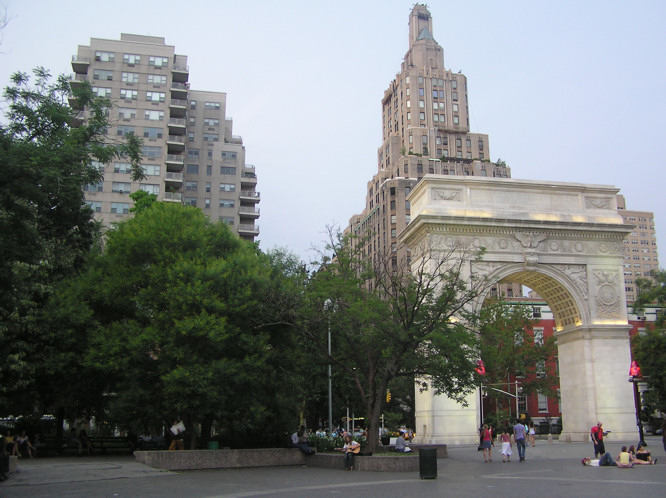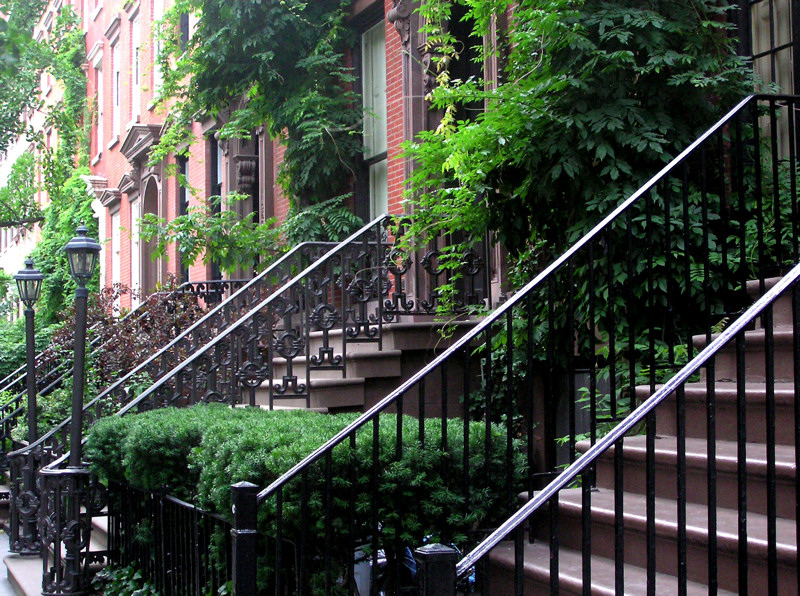Greenwich Village
Directions - In Greene Street at the next junction turn right down Princes Street. Walk 2 blocks and turn left into Broadway. Go down the Broadway Lafayette Street Subway Station. Take the S,V,6, (local, not express) train uptown, Get off at West 4 Street, Washington Square Station. The 'Village' is from Broadway west to the Hudson River, bordered by Houston Street to the south and 14th Street to the north. Be prepared for some strange sights on the streets. It is the gay, lesbian and transvestite centre of New York and some residents have the need to display their sexuality very overtly. Serpentine Bleecker Street stretches through most of the neighbourhood. Washington Square and its arch is the heart of the Village. As soon as you get out of the subway station you know you have arrived at a different district of New York. The first thing you notice is that the High-rise office tower blocks have disappeared. You will find quaint side streets and stunning historic brownstone. (St Luke's Place and Morton Street are supposed to be very attractive. They have stunning rows of lovely houses from the 1850's - it's a very charming, romantic scene and probably one of the most beautiful blocks you'll find in the city).

By day, it is a quaint little village with cute storefronts and interesting shops. The shopping in Greenwich village is amazing! If you're looking for anything eccentric, funky, inspiring, or just plain different, this is definitely the place to look. I was amazed at what you could buy for your dog in some of these stores. The streets are also lined with classic coffee shops...the kind you usually see only on hip television shows. By night, Greenwich Village goes through an extreme makeover. The area suddenly goes from quaint to crazy. Dance, comedy and even strip clubs become packed with people of all kinds looking for a good time. A very gay-friendly area largely in evidence around Christopher Street and Sheridan Square. Greenwich Village Tree-lined streets crisscross and wind, following ancient streams and cow paths. Each block reveals yet another row of Greek Revival town houses, a well-preserved Federal-style house, or a peaceful courtyard or square. It defies Manhattan's orderly grid system. Big gentrification area and escalating real-estate values. Very trendy.

Greenwich Village's shorter buildings allow more sunshine to reach the streets. There are many secret courtyards and small gardens nestled between townhouses in the residential blocks of Greenwich Village. Manhattan's Greenwich Village offers visitors an escape from the skyscrapers. The Dutch bought Manhattan Island from the Indians in 1626; and at that time the area which we know as Greenwich Village was primarily a woodland with deer, elk, woodchuck and other creatures. The Village soon became known as the best tobacco plantation in the colony, and under the direction of the Dutch West India Company, tobacco plantations flourished. After the British captured Nieuw Amsterdam in 1664, a commander of the fleet of English warships named Sir Peter Warren in 1731 purchased a large portion of the Village plantation, where he lived with his family in a beautiful mansion overlooking the Hudson River. He named this farm Greenwich.
Washington Square Park and Chess corner
Directions - Get off the subway at West 4 Street, Washington Square Station. Walk right and visit the Square. Come back towards the Subway station. Walk west along West 4th Street. Cross the big road called Ave of the Americas. Take the next left called Cornella Street. At the T junction turn left and then first right into Leroy Street. Go straight at the next multiple junction. This leads into is one of the pretty roads called St Luke's Place. Walk west for two blocks and turn right into Greenwich Street (take Photo) Take the next right an walk back on your self up Morton Street again one of the pretty streets. Walk for two blocks and then turn left for four blocks until you hit a T junction with Christopher Street. Turn right. This is the lively gay area. Keep walking for two blocks. Take the subway uptown at Christopher road - Sheridan Square station to 34th Street Penn Station
Anyone can play on the public chess sets at Washington Square Park. If you don't want to play you can watch peoples' moves, or just people watch. You will find it in the south west corner of Washington Square park. There are built-in solid public chess tables and benches. It can get crowded with lots of watchers especially at the weekend. The Washington Square tables form the cornerstone of what is called Manhattan's "chess district," as the area around the park (Thompson Street, between West 3rd Street and Bleecker Street) has a number of chess shops, the oldest being the Village Chess Shop, founded in 1972. There is also a Scrabble playing area.
There are a number of statues in Washington Park in Greenwich Village. Of course there is a statue of George Washington. There is also a statue of Italian patriot and soldier Giuseppe Garibaldi, commander of the insurrectionist forces in Italy's struggle for unification, and one to Alexander Lyman Holley, a talented engineer who helped start the American steel industry after the invention of the Bessemer process for mass producing steel.
Unlike some other parks Washington Park has a low crime rate. Still look after your belongings but it is very family orientated. There is a children's play areas, trees and gardens, paths to stroll on, park benches, picnic tables and two dog runs. The New York City Police Department operates CCTV cameras in the area. The New York University Department of Public Safety also keeps a watch on the park, and the city parks department has security officers who sometimes patrol the park. Enjoy the park.
The history of Washington Park goes back to before the first white settlers. The land where Washington Park is now based was divided by a narrow marshy valley through which Minetta Creek ran. In the early 17th century, a Native American village known as Sapokanikan or 'Tobacco Field' was nearby. They also owned the land known now as Washington Square Park before the Dutch attacked and drove them out. By the mid-17th century, the land on each side of the Minetta was used as farm land by the Dutch. The Dutch gave the land to slaves, thus freeing them, as a reward for protecting the area from attacks of the Native Americans. The slaves that received the land were told that, although they were no longer slaves, they had to give a portion of the profits they received from the land to the Dutch East India Company. Also, their children would be born as slave, rather than free. It became known as "The Land of the Blacks". In April 1797 the Common Council of New York purchased the fields and used it for burying the poor. It was also used as a plague pit. Those New Yorkers who died from the early 19th century Yellow Fever epidemic were buried here as at that time this land was outside the New York City limits. There are believed to be over 20,000 dead bodies under Washington Park. This is one of the reasons it has not been built on. look out for the ghosts in the evening (only kidding).
There is a large Elm tree in Washington Park called Hangman's Elm. Recent research has shown this was never used as a gallows as this location was inside the rear garden of a now demolished private house. The correct location of the public gallows was in two different places, One was erected where the Arch is now and another was built near the fountain. Crowds of New Yorkers would attend the day of a hanging for entertainment. Food sellers would move through the crowd. Criminal pickpockets would try their luck whilst peoples attention were fixed on the kicking legs of the condemned hanging from the rope as they chocked to death.
In 1826 the City of New York bought the land and formed it into a square to be used as the Washington Military Parade Ground. These Military parade grounds were public spaces specified by the City where volunteer militia companies responsible for the nation's defense would train. The streets surrounding the square as in the fashionable squares of London, became one of New Yorks city's most desirable residential areas in the 1830s. The Greek Revival neo classical 'Georgian' style houses on the north side of the park remain from that time. They have a preservation order protecting them for future generations to see.
In 1850 the parade ground became a public park. More trees and flowers were planted along newly built paths. The newly-formed New York City Department of Parks took over responsibility of maintaining Washington Square Park. In 1889, to celebrate the centennial of George Washington's inauguration as president of the United States, a large plaster and wood Memorial Arch modeled on the French and Roman triumphal arches in Europe, was erected over Fifth Avenue just north of the park. The temporary plaster and wood arch was so popular that in 1892 a permanent marble arch, designed by the New York architect Stanford White, was erected, standing 77 feet (23 m) was built just inside the park. In 1918 two statues of George Washington were added to the north side.
Travel books

